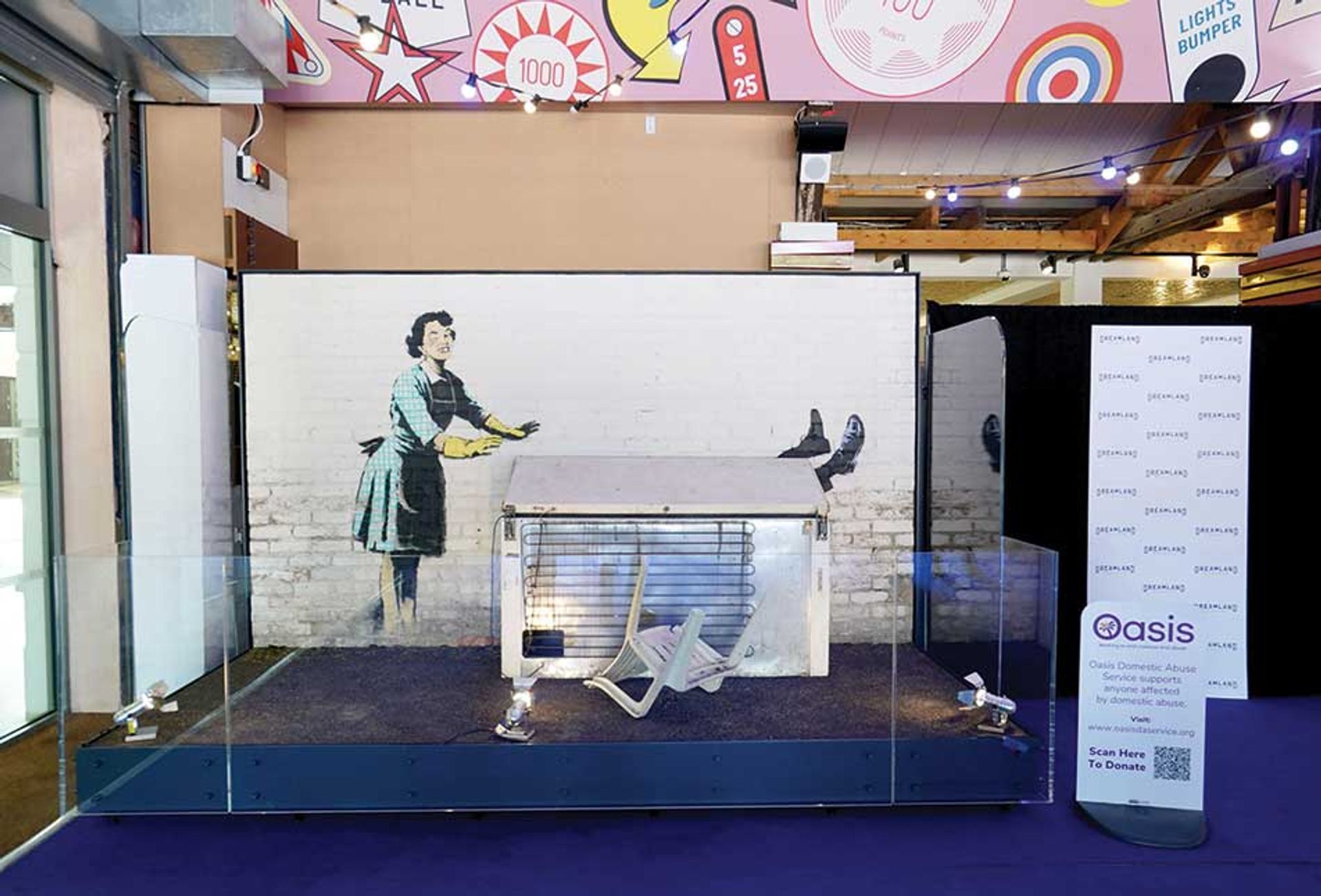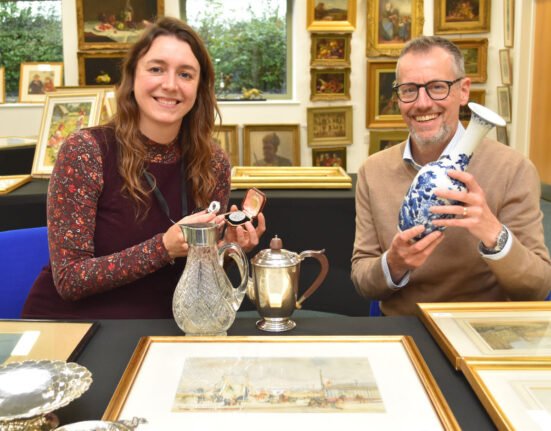“Invest in one of the best performing asset classes of the decade.” “Invest like billionaires.” “Six reasons to invest in blue-chip art.” “The art market is booming. The time to invest is now.” So read the straplines of just some of the targeted advertisements currently filling potential collectors’ and, perhaps more accurately, investors’ inboxes and social media feeds around the UK.
The senders of these messages comprise a subsector of galleries that has sprung up across London over the past few years. They explicitly frame art as a safe haven for capital in times of economic uncertainty and claim the returns on blue-chip works of art have consistently outperformed the FTSE 100 share index. For this group of sellers—call them “investment galleries”—art may enrich people’s lives, but its foremost value lies in diversifying their portfolios and delivering profits.
Among this group is Quantus Gallery, originally founded by the former Citi wealth manager Ryan Marsh, as a space to sell NFTs (non-fungible tokens) in 2021, at the height of the cryptocurrency boom. Today, the London dealership’s focus is on brand-name artists such as KAWS, Banksy and Yayoi Kusama. The gallery operates a business model whereby clients “invest” in works of art that are then stored by the gallery for a recommended two-to-five years before being resold. A single commission of 20% of the resale profit is payable to Quantus upon each transaction’s completion.
An investment brochure published by Quantus last year states that art is “one of the most popular safe havens, mainly due to the fact that the price of art does not correlate with the stock market”. However, on its website, the gallery acknowledges that “like any asset, the value of art can rise as well as fall. Depending on the artist’s performance and their future collectability, there may be a risk that the projected returns are not achieved”.
Another newcomer is Pictorum Advisory, which was founded in 2018 by Matthew Navin, a former finance professional, and his brother Jackson. In 2022, the pair expanded from advising clients into exhibiting and selling works by opening Pictorum Gallery in Marylebone; another venture of theirs called UMA Gallery, which will encompass art, fashion and music, is in the pipeline. Matthew Navin tells The Art Newspaper that the gallery’s role “remains primarily objective” compared with the advisory, “where we understand the complexities of considering art as an investment”.
Snobbery was the catalyst for launching the business, says Navin, who himself faced “challenging experiences” while trying to gain access to the art world, prompting him to want to make the market “more accessible and less intimidating”. He adds: “By providing access to a marketplace historically reserved for the elite, we commit to creating an equilibrium in what was once a classist space.”
Investors make up a “significant portion” of Pictorum Advisory’s clientele, Navin says. “They tend to make decisions more swiftly compared to collectors,” he adds. “This speed often stems from their focus on the financial aspects of art acquisition, requiring less emotional or visual stimulation during the purchasing process.” Pictorum clients’ art investment portfolios are typically 70% focused on financial returns over the first three years, after which time Navin notes that “portfolios tend to evolve to a 50-50 [split] between investment-driven acquisitions and purchases driven by collector-oriented motivations, such as philanthropic, social, emotional, intellectual or academic pursuits”.
Motives in flux
The growing crossover between art and luxury brands appears to be galvanising the phenomenon for “investment galleries”. “It’s not about who’s got the best watch or car, it’s about who’s got the best work of art,” says Benjamin Griffin, a sales director at Yield Gallery, which focuses on street artists such as Banksy and Richard Hambleton. Much of the dealership’s inventory comes from the owners’ personal collections.
Bobby Izzard, a manager at Yield Gallery, which opened in Blackheath, south-east London, in 2019 and plans to open a new space in Fitzrovia this summer, says the trend towards investment is being driven by demand from buyers. The gallery’s promotional material cites data from the 2023 Art Basel and UBS Survey of Global Collecting, which reveals that, although buying for pleasure is the highest motivation (37%) among the 2,800 high-net-worth collectors who responded to the survey, a substantial share (28%) is driven to collect by financial motivations.
Crucially, the report also found that buying art using credit or loans was widespread in 2022-23 despite only 10% of responding collectors identifying themselves as “investors”. Around 54% of all financially motivated buyers used credit or loans to purchase art, as did 39% with “non-financial motivations”. Around 43% of high-net-worth collectors and 39% of ultra-high-net-worth collectors (those with at least $50m in assets) deployed credit or loans for art acquisitions. One-third of the latter group even said they had purchased more than half their collections via outside financing. As lofty interest rates slow lending, question marks could hang over some of the financial arrangements underpinning this segment of the art market.

Red Eight Gallery is selling fractionalised shares, starting at £150, in Banksy’s Valentine’s Day Mascara
Photo: PA Images/Alamy Stock Photo
Beyond disrupting some of the characteristics of the traditional gallery model built on prestige and privileged connections, some so-called “investment galleries” have caused an ethical stir. S&P Gallery was expelled from the Fine Art Trade Guild in 2022, according to a report on the financial website This Is Money, after the organisation received a “number of complaints” about the gallery’s conduct. S&P had claimed on its website that “benefits of using our art investment service include: Regulated by the Fine Art Guild so guaranteed provenance [sic]”.
Daniel Tunkel, a partner at the London law firm Memery Crystal who specialises in financial regulation, points out that works of art are not themselves investments overseen by the UK’s Financial Conduct Authority (FCA). “Buying and selling art is not a regulated activity, nor is providing advice on art collection or art valuation,” he says.
Tunkel warns of comparisons between the performance of the art market, or even the works of a specific artist, and conventional investments such as stocks, bonds or commodities. “It may be fair to make such comparisons for some purposes and completely misleading to do so for others,” he adds.
Rethinking the ‘enjoyment of ownership’
One area where FCA regulation could bite, Tunkel says, is in the selling of fractions of works of art. The Financial Times reported in March that the Liechtenstein-based online platform Artex, which is selling fractionalised shares in a $52m Francis Bacon painting, had to walk back claims that the exchange and its share sale were approved by the Financial Markets Authority of Luxembourg. Having previously named the storied investment bank Rothschild & Co as an adviser to the exchange to The Art Newspaper and others, Artex has also since said Rothschild is not involved.
A number of bricks-and-mortar “investment galleries” are also beginning to deal in fractionalised works. Among them is Red Eight Gallery, which launched a scheme last year to sell shares in Valentine’s Day Mascara, a mural painted by Banksy on the side of a house in Margate in February 2023. Tunkel suggests the venture would be deemed a collective investment scheme in a court of law.
“Selling a picture is not regulated, but constructing and marketing a scheme under which interests in that picture are sold as economic fractions very likely is regulated,” he says. “Those fractions are the interests regulated as investments, and this type of structure is referred to in law as a collective investment scheme. It’s a complicated area of law and regulation, and it is not at all clear that those in the art market attempting to deal in fractions have taken the proper advice.”
According to a spokesperson for Showpiece, the online marketplace working with Red Eight to sell the Banksy shares, “extensive legal opinion” was sought “on how to structure the Showpiece digital collectibles proposition prior to launching the platform, and we are confident this is not a collective investment scheme”. The spokesperson adds: “As a digital collectibles platform, focused on the enjoyment of ownership as opposed to the financial gain, this would not be considered a collective investment scheme… We differ significantly from fractional investment platforms, in that there is no reference [in marketing materials] to proactive sale of the asset nor any mention of future appreciation.”
One can certainly debate how much enjoyment can be had from what Showpiece’s website calls “legal beneficial ownership” of a small part of a work of art and “not a literal physical piece”. But unless a judicial ruling or regulatory action upends this space, it is likely that more and more sellers will try to expand the art market by pitching benefits that smack of our increasingly financialised era.







